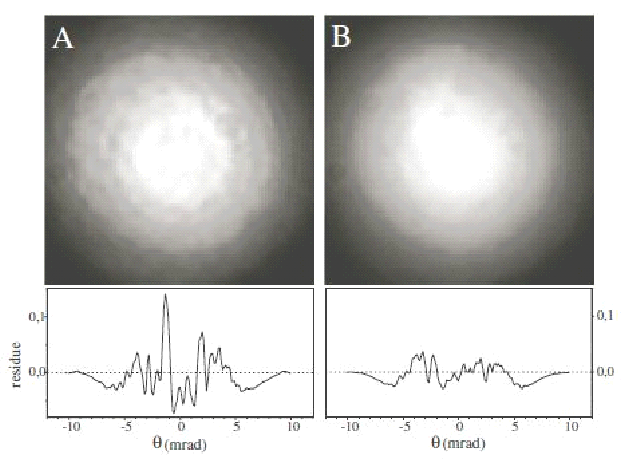In classical optics, in order to narrow the width of the light beam comming up from an extensive source, a focus lense and a pinhole is used. That type of setting produces great losses in the intensity of the light and there is no improvement that can be achieved with use of more lenses, mirrors and screens.
However, with the help of nonlinear optics there is hope to go beyond the limitation. If the light changes the optical properties of a material system during its propagation, than the beam itself can be modified, too. That can enhance a whole spectrum of interesting and unexpected processes that can be observed and used [1]. Shortly after the creation of the first laser, a spontaneous formation of spatial structure of a laser beam, has been reported. The processes of self-focusing and self-trapping of light have been explored in different media such as photorefractive crystals, liquid crystals or semiconducting materials and also … in the cold atoms vapors.
Despide the fact that cold atoms are known to be useful tool for testing theoretical models, to be our only chance to obtain a glimpse of the world that is governed by quantum laws much like those from science fiction scenerios, there has been no practical use of them whatsoever. But it doesn’t have to be this way. Maybe, in future, they actually can become an alternative for traditional way of collimating light from extensive sources.
Why? In order to answer this question lets take a closser look into the result of the experiment that was performed in Institut Non Linéaire de Nice in France [2]. In the experiment, a cloud of cold Rb85 atoms has been prepared in a magneto-optical trap and a single transition of resonant excitation between two hyperfine levels F=3 and F=4 has been selected. The excitation is responsible for the saturation of the medium. The simplified scheme of the experimental set up is presented in Fig. 1.

Fig. 1 shows the vapor cell together with the trapping laser beams (two additional not seen are in the direction perpendicular to the picture), the magnetic coils that allow to localize the cloud in the center of the trap, and the passing probe beam.
The results of the interaction between the atom sample and the laser beam are reflected in an increase of the laser beam intensity in the zero transverse wave vector compontent for high enough values of the saturation parameter, defined as s(x,y)=I(x,y)/I_sat, where the I(x,y) is the initial intensity of the beam, and I_sat is the saturation intensity. In the experiment with the Rubidium atoms I_sat=1.6mW/cm2.

Fig. 2. A comparision between the intensity distribution for the beam (the picture is taken with CCD camera) after the propagation through the cell (the image of the density distribution of the atom has been removed). The grey scale stands for values of the beam intensity; white color means large values of intensity. The is 25% higher for parameter s=1340 (B) then for s=50 (A).
For the collimation of the beam, the most important is the reduction of intensity of modes that are not parallel to the direction in which the light propagates . In the Figure 3, it is shown that those modes are limited in the beam that has passed through the vapor cell loaded with atoms.

Fig. 3. The distriubtion of the intensity of the beam after the propagation through the cell without any atoms in it (A) and with the atoms present (B). The top pictures are taken by the CCD camera, the bottom part is a cross-section along a perpendicular axis passing through the beam center. It shows the deviation from a Gaussian profile. The RMS value for fluctuations is reduced by the factor of 3.5 when the vapor cell is loaded with atoms.
The results of the experiment show that the beam can be collimated after passing through the cold atoms with relatively low intensities. The great advantage of using atom probes to determine how the medium responds to the light is that the phenomenon is decribable by a simple theoretical model, and fluctuations in the medium are eliminated. The fluctuations can demage the sample in case of, for exemple, crystals or semiconductors.
It is interesting, that there exist different types of nonlinearities that can help to focus a beam with even lower intensities of an incident light than were presented. Moreover, the atoms do not have to be cooled down to extremely low temperatures. Atoms in room temperature, can serve as a convenient nonlinear medium, as well. They are technologically easier to use, the nonlinearity is fairly easy and understood, but there are complications with respect to a Doppler broadening and an interaction with different classes of velocity that have to be taken into account. It is an obstacle that can be removed only at cost of lower value of nolinearity coefficient for atomic sample.
However, the creation of the magneto-optical trap (MOT) is still difficult and demanding proces. The system is still rather complicated, expensive and it demands a whole group of people that has to stand behind and operate it
Even if miniaturization and simplification of the experimental setting seems to be hard to overcome, perhaps also this time the need will be the mother of invention.
References:
1. R. Boyd, Nonlinear optics, Academic Press, 1992.
2. G. Labeyrie, T. Ackemann, B. Klappauf, M. Pesch, G-L Lippi, R. Kaiser Eur. Phys.J. D 22, 473 (2003)
Katarzyna Targońska, December 1-st 2010
